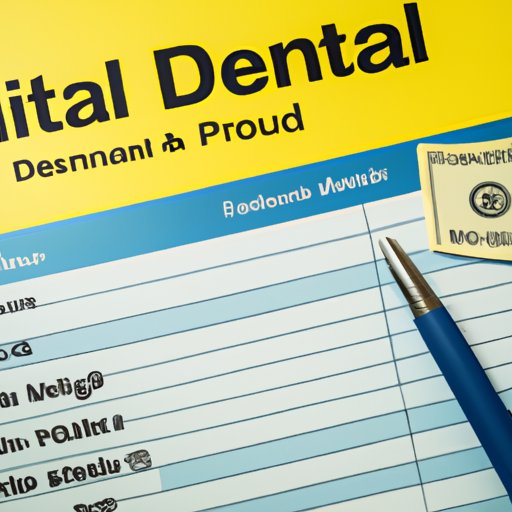Introduction
A dental filling is a procedure used to repair a small cavity or crack in a tooth. The process involves removing any decayed or damaged material from the affected area and filling it with a special material such as amalgam, composite, gold, or porcelain. Although dental fillings are a common and relatively inexpensive way to restore teeth, many people are curious about the cost of a filling and how to get the best deal.

A Comprehensive Guide to Filling Costs: What You Need to Know
The average cost of a dental filling can vary greatly depending on the type of filling used and other factors. According to the American Dental Association (ADA), the cost of a single filling can range anywhere from $50 to $300, with the average being around $150.
When it comes to paying for a filling, there are several options available. Most dentists accept major credit cards, cash, and check as forms of payment. Additionally, some dentists may offer payment plans for those who cannot pay for their treatment in full at once. Insurance coverage may also be available for some procedures, although it is important to note that the amount covered by insurance will depend on your specific policy.
How Much Do You Really Pay for a Tooth Filling?
When considering the cost of a dental filling, it is important to compare prices for different types of fillings. Amalgam fillings, for example, are usually the least expensive option and can cost as little as $50 per filling. Composite fillings, which are made of plastic and glass particles, typically cost more than amalgam fillings, ranging from $90 to $250 per filling. Gold fillings are the most expensive option, costing up to $500 per filling, while porcelain fillings can range from $250 to $500.
It is also important to shop around and compare prices before making a final decision. Different dentists may have different pricing structures, so it is always a good idea to get quotes from multiple providers before settling on one.
An Overview of the Different Types of Fillings and Their Prices
Amalgam fillings are made of a combination of metals, including silver, tin, copper, and mercury. They are one of the most common types of fillings and are generally the least expensive option, costing between $50 and $150 per filling. Amalgam fillings are durable and long-lasting, but they may require more frequent replacement than other types of fillings.
Composite fillings are made of a mixture of plastic and glass particles and are designed to match the color of your natural teeth. They are usually more expensive than amalgam fillings, costing between $90 and $250 per filling. Composite fillings are also less durable and may need to be replaced more often.
Gold fillings are made of a combination of gold, copper, and other metals and are the most expensive type of filling. They cost between $200 and $500 per filling and are generally very durable and long-lasting, although they may require more frequent replacement than other types of fillings.
Porcelain fillings are made of ceramic and are designed to match the color of your natural teeth. They are usually more expensive than other types of fillings, costing between $250 and $500 per filling. Porcelain fillings are also highly durable and long-lasting.
What Factors Determine the Cost of a Filling?
The cost of a dental filling can vary depending on a number of factors. One of the most important factors is the location of the dentist. Dentists in larger cities or metropolitan areas tend to charge higher rates than those in smaller towns or rural areas. In addition, the type of filling used can also affect the cost. As mentioned earlier, amalgam fillings are usually the least expensive option, while gold fillings are the most expensive.

Exploring Payment Options for Dental Fillings
If you are unable to pay for your dental filling in full at once, there are several payment options available. Most dentists accept major credit cards, cash, and check as forms of payment. Additionally, some dentists may offer payment plans for those who cannot afford to pay in full. Additionally, some insurance policies may provide coverage for dental fillings, although the amount covered will depend on your specific policy. Finally, some dentists may offer discounts to patients who pay in full or who have certain types of insurance.
Conclusion
Dental fillings can be an effective and relatively inexpensive way to restore teeth. The cost of a filling can vary depending on the type of filling used and other factors, such as the location of the dentist. When considering the cost of a filling, it is important to compare prices for different types of fillings and to explore payment options, such as insurance coverage and payment plans. To get the best deal on a dental filling, it is important to shop around and compare prices from multiple providers.
(Note: Is this article not meeting your expectations? Do you have knowledge or insights to share? Unlock new opportunities and expand your reach by joining our authors team. Click Registration to join us and share your expertise with our readers.)
